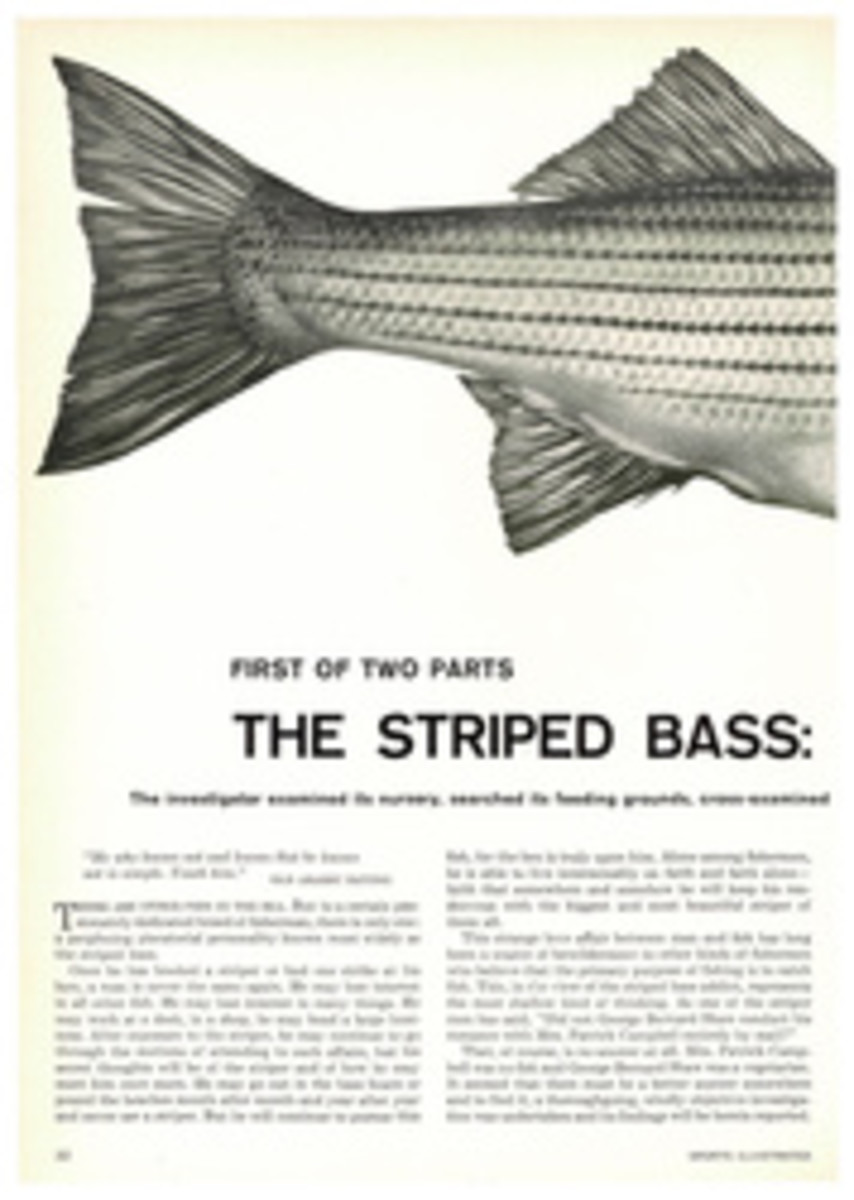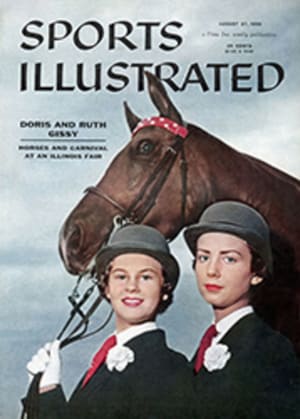
GREAT AND CRAZY HORSE SHOW
DUBLIN
If one of the judges were actually lynched in the show ring, or a peeress of the realm took a champagne bath in public, that could cause surprise to frequenters of the Royal Dublin Society's Horse Show; practically nothing else could. The hurling of bricks this year through the plate glass of the Russell Hotel where the visiting jumping teams were staying caused only mild comment. A brief effort was made to give the incident a political slant by suggesting that the brick thrower was a Greek trying to upset the Turkish team, but it was later agreed that it was merely the act of someone entering with extra vigor into the spirit of horse show week.
Newcomers were, as usual, somewhat startled by such traditional goings on at the hunt balls as white-tied leaders of rank and fashion stripping to the waist and jumping off the balconies at 4 in the morning. On the other hand, Miss Norah Fitzgerald, prominent alike as wine merchant, hostess, sportswoman and philanthropist, who has seen more shows and hunt balls than most people her age, found the Meath Ball so lacking in sparkle that she sent out for a set of chessmen and a board and whiled away the early morning hours playing this game amid the popping champagne corks and the dancers.
Out at the Ballsbridge show grounds, the collective excitement and interest of about 50,000 people were about equally divided among the Brazilian jumpers who looked as if they were winning everything right up to the moment when they suddenly collapsed, the great row over the judging of the hunter championship and the question of whether the Suez crisis was going to frighten a lot of English money away from the bloodstock sales.
People said it was on account of Suez, because nobody likes to think that demand is maybe falling off anyway. But whatever may be the truth about that, it is a fact that yearling sales were much fewer than last year.
Out of 224 lots catalogued, 179 were offered and only 92 sold. Sold for a total of $47,604—giving an average of $517 per animal. That was 43 lots less than were sold last year, and the average price was down by $147. And last year had shown a decline on 1954.
RHUBARB, BUT NO RESIGNATION
The great row came about through the assertion of many—speaking bitterly and with foul oaths—that Peace Pact, which only achieved the status of reserve heavyweight carrying hunter, was a much better horse than Mr. T. D. Dreaper's Man o' War, the 4-year-old gelding which was awarded the championship of the show. Mr. Galway Greer, who won the championship in 1953 and 1954, took a look at Man o' War and said, "If that's the winner, God help Ireland."
There was an unprecedented delay of just over an hour while the judges wrangled about the final selection of the champion, and two of them threatened to resign rather than agree to the choice of Man o' War. However, nobody did in the end resign, and Man o' War got the top award.
Hunting men were particularly pleased by the success of Mr. Frank Boland's Merrion Kilglass, which won Class 11 for weight carrying hunters, 15 stone and upwards, 6 years and older. Merrion Kilglass is a full brother to The Quiet Man of the Italian jumping team and used to hunt regularly with the Ballymacad hounds. At Balls-bridge he seemed to be the answer to those critics who like to pretend that weight carrying winners at Dublin are show-offs and nothing else—would be no use in the hunting field. He jumped the course and—except for one very minor fault—had a clear round.
A surprise for one and all—and a money loser for those who rashly like to bet on the jumping—was the final showing of the Brazilian jumping team. Right up to the start of the competition for the Aga Khan Challenge Trophy—the main event—the word among the experts had been that the Brazilians, despite their horses being small (Bibelot is not much bigger than a pony) and having a very strange jumping style, were going after all to wipe the turf with the British and the Americanos del norte. And in fact they did very well indeed during the first days of the jumping.
Their little horses are by English sires out of Brazilian dams. Their style consists in stopping nearly dead at the jump and then bucking over it. They contort themselves like dogs going over a fence. People thought that if they could win despite all this, as they did at Aachen, they must have first chance at the Aga Khan Cup.
In the event, Travessura twice threw his rider, Pedro Corvello, and Caramela, with the same rider, gave every appearance of being partially crazed by the excitement of the occasion and ran up 33 faults in the first round. After the second fall of Travessura, Pedro Corvello was led off the ground hurt, and the Brazilian team withdrew.
TURKS KICKED BACK
Lieutenant T. Moroney, who jumped, on Ballynonty, a clear round which helped to put the Irish team into third place, ahead of the Americans, says he believes the Brazilians had just done too much jumping on their current torn and that their horses, instead of being, as they looked, too hot, were as a matter of fact a bit stale. The Turks, who were placed second, might actually have won this supreme trophy but for one curious fault their horses seemed to have in common—that of kicking back at the jump after they have got over it and dislodging the pole with their hind feet. It was a trick which cost them a lot of faults.
Though the Americans—with Master William, Hollandia, Belair and First Boy—achieved only fourth place, it is true that their style was justifiably the most admired in the eyes of the most critical horse show audience in the world. (The crowd at Ballsbridge watches the jumping, and particularly the Aga Khan Cup, with an intensity of emotional attention which one normally associates only with the running of the Derby or the Grand National.)
People who had seen the Americans jump last year were particularly impressed by the enormous improvement in the smoothness of their jumping style, and when Hugh Wiley on Master William jumped a clear round at the outset, a lot of people thought the trophy was in the bag for the United States. The clear round was especially creditable since Master William had been visibly much upset by the playing of all the national anthems during the parade at the outset and the disturbing noise of the Irish army pipers playing marching tunes on Scottish bagpipes. One observer describes him as jitterbugging right through the parade.
The winning British team was the only one to include women—Miss Dawn Palethorpe, who had a clear round on Earlsrath Rambler, and Mrs. Bryan Marshall, whose Welsh horse Nobbler nearly lost them the Cup by refusing three times and getting eliminated. The British team was notably cosmopolitan: with the exception of Nobbier all its horses were Irish-bred, and John Lanni, rider of Huntsman VI, is Italian-born.
Compared to the Americans, the British riding and jumping style—except that of the masterly Lieutenant Colonel Harry Llewellyn—seemed so much less smooth as to appear almost fussy, as though the riders and horses were both so keen to win that they were nearly quarreling about how best to do it. Possibly the most sensational single achievement was that of John Lanni, who fell on the bank in the second round, held on to Huntsman VI, remounted and got home with only half a time fault—equivalent to a delay of just two seconds.
Probably the only unhappy man in the whole of the vast crowd at Balls-bridge was a certain Doctor Andrews, head of the Irish Turf (peat) Board who hates every aspect of the horse. He had to attend the show this year as a courtesy to three visiting Russians—deputy ministers of Fuel and Power from Moscow. He hoped and believed that they would share his disdain for the horsy events and sought to rivet their attention on the flower show and the industrial exhibits. His effort was in vain. The Russians loved the display of fashion in the jumping enclosure, loved the pipe bands, loved the horses, loved every minute of the jumping. Doctor Andrews was there all day and later turned up at the British Embassy cocktail party in a state of exhaustion, trying to fight down a feeling that the Russians are not as serious-minded as they ought to be.
PHOTO
SEDATE HORSES are led past stands by champion hunter of show, Man o' War. Mrs. Tom Dreaper, wife of owner from Killsallaghan, County Dublin, heads parade on winner.
FOUR PHOTOS
FAR FROM SEDATE antics of the after-show set included tablecloth-draped dancing and wild jitterbugging. But a slightly bored Miss Norah Fitzgerald whiled away the small hours at the Meath Ball with a chessboard and a similarly inclined partner.

